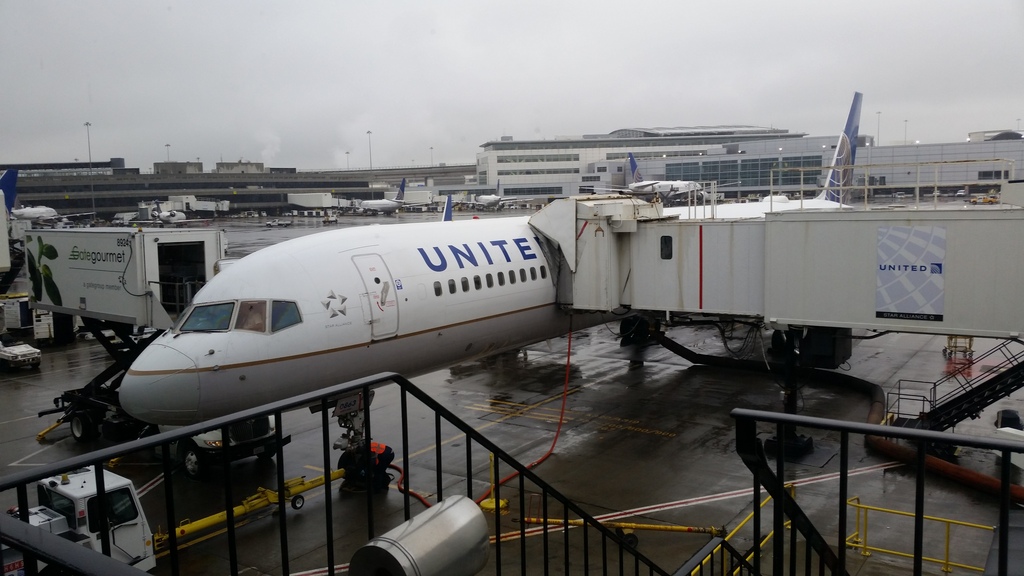United Airlines flight 1001 from Los Angeles to Denver lost a tire during takeoff this morning at around 7:15 a.m. Pacific time. The pilot reportedly announced what happened to passengers on board as they continued their flight to Denver as planned. Flight attendants ran everyone through brace procedures, prior to making an emergency landing.
Fire trucks and emergency crew met the aircraft on arrival, and maintenance confirmed both that there was a tire missing and an issue with another tire as well. The Boeing 757 was then towed into the terminal, where the flight arrived 23 minutes late. Fortunately the 757 has plenty of tires!
A United Airlines spokesperson offered,
United Flight 1001 landed safely in Denver after losing one wheel on takeoff from Los Angeles International Airport.
The wheel has been recovered in Los Angeles, and we are investigating what caused this event.

United Airlines Boeing 757
According to one of the 174 passengers on board the aircraft, “Not the smoothest landing but we landed…Nobody panicked or got stupid.” The airline even held the passenger’s connecting flight (“ConnectionSaver“) and their luggage was taken off of the occurrence aircraft and transferred to their connecting flight on time.
The 30 year old legacy Continental Airlines 757, registration N14107, has previously ingested a ballon and had smoke in its cockpit.
United has faced a number of high profile, reported issues this year, including loss of a tire on departure from San Francisco where damage was caused to cars in a parking lot. They were under FAA restrictions that kept the airline from starting service to new cities and putting new aircraft into commercial operation.


Did they lose a tire or a wheel? Or two?
It’s more surprising that the crew was willing to retract the landing gear knowing that that they had lost a wheel but without an inspection to make sure there was no damage to the aircraft or landing gear.
They could not have flown LAX to DEN wheels down.
AA has no 757s in service, probably a smart decision in retrospect even considering the delays in getting new Boeing planes. The maintenance problems must be costly and the delays for scheduled 757s frequent for UA.
Of course I have zero hours in a 757 and still know better than the crew who has been trained for this and was dealing with the real world. Give me attention!!
Doesn’t the gear come up like 2 seconds after takeoff? Listening to the ATC recording I don’t think they were advised until the tower was about to send them over to departure.
United must be asking why does this keep happening? FAA did clear them.
And let’s also second guess the other United plane that hit a bird on takeoff while United 1001 was landing.
The worst way United can respond to this is to pin this on Boeing. Older planes like this 757 are last touched by the airline’s maintainence facilities.
Flying 30 year old commercial aircraft is definitely a way to overspend on fuel and not get the profit on flights.
Sure sounds like this could of been a very scary situation for the airline indeed, but luckily cool heads prevailed through such a crazy situation and that is an important. If you panic during dire situations, then can end up much worse and you’ll find yourself making stupid mistakes, but luckily that did not happen this time, so you gotta give the crew props for that ! But, on the other hand maintenance on every airline should be done thoroughly & by the book and if need be double check to make sure the job is done properly because you don’t want any other bad mistakes happening with flights
When the plane is “paid for”, then maintenance becomes the leading cost (other than crew of course) of operation. Very similar to Delta’s 757s and their old MD-88/90s. They can still make money. The Mad Dogs have been replaced with the much better A220s. As much bad press that Boeing (deservedly) gets, this one ain’t on them! Too bad the government let Boeing buy their way out of criminal activities. Boy, Robin. That was ONE LONG run on sentence.
PLEASE do not perpetuate misleadingly inaccurate media misstatements, particularly when the accurate facts are known to you or published before your reporting.
A WHEEL fell off of that plane, not merely a “tire”.
Your background should have caused you to instinctively realize it is almost impossible for just a tire to “fall off” from a plane’s landing gear, so it most likely was a “wheel”, not a “tire”.
Anyone up for a 757MAX or a 797???
Tim Dunn is correct in this case. The gear shouldn’t have been retracted and the aircraft should have returned to the field. With suspected gear damage you don’t retract them because you might not get them back down! On the subject of the wheel coming off, it has nothing to do with the make, model or age of the aircraft, that was a maintenance mistake pure and simple. A tire change is about the easiest task to perform on airplane. Screwing it up shouldn’t happen. It is normally ( at least at my airline) backchecked by a second mechanic for SAFETY. There is one big nut which screws onto the axle, saftied by two 1/4″ bolts, with thier own locking nuts, with the heads installed so if these nuts come off, centrifugal force holds the bolts in place until the wheel spins down. If these locking nuts and bolts are left off, the axle nut could spin loose while the tires are turning and fall off the axle allowing the wheel to follow. It seems to be happening all too much lately. I don’t know the mechanics responsible for these incidents, so I can’t speak to their situation, but there seems to be a deeper problem in UAs maintenance department.